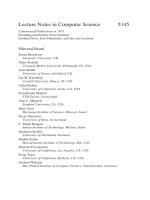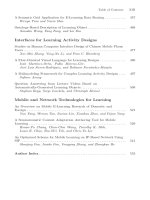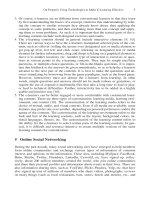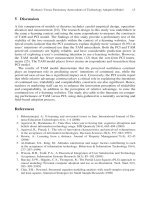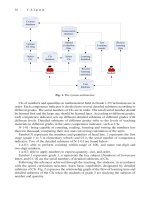Lecture Notes in Computer Science- P70 ppt
Bạn đang xem bản rút gọn của tài liệu. Xem và tải ngay bản đầy đủ của tài liệu tại đây (2.46 MB, 5 trang )
334 P C. Chan et al.
In order to supplement insufficiency of artifacts collected by the museum, folklore
hobbyists are regularly invited to demonstrate their private collections. At the mean
time, the task force of digital preservation team of the museum digitizes the artifacts
for extending its contents. Table 2 shows the exhibitions of the folklore artifacts col-
lected by hobbyists and folk arts created by folklore artists at the Taiwan Folklore
Museum from 2005 to 2007. Another way to aggressively increase the number of
digitized contents is to sign cooperation agreements with members of the folklore
associations by giving services to digitize their personal collections. We expect that
after having extended the digital contents, the web site of Taiwanese Folklore Mu-
seum will become even more popular for teachers and students, especially in the kin-
dergartens and primary schools, to extract and prepare useful materials for folklore
education.
Table 1. Statistics of educational groups and persons who visited Taiwan Folklore Museum in
2006
School Number of School Number of Persons
University 14 364
High school 5 747
Junior high school 7 340
Primary school 37 2079
kindergarten 199 10988
Pre- kindergarten 66 2533
Table 2. Summary of culture and art exhibitions at Taiwan Folklore Museum from 2005 to
2007
Exhibition Name
Exhibition Name
Item Example
item
Example
y
awan r ss
00
m
d
Digital Content Development of Folklore Artifacts and Activities 335
2 Materials and Methods
The task force is consisted of multi-discipline scholars, including folklore specialists,
archivists, and academic researchers majored in computer and information sciences.
Their dimensions, originalities, functions, and other detailed descriptions were exam-
ined, investigated, and recorded by folklore specialists. Metadata based on the Dublin
core were also constructed for compatible with international standard. Finally, a
database system and a website were designed for providing general publics and re-
searchers to browse and surrogate the digital contents.
2.1 Digitization of Folklore Artifacts
Pictures of the artifacts were taken by a professional photographer using a profes-
sional Hasselblad camera with 120mm positive films. Three infrared-synchronized
spotted lamps, one was placed above the artifact and the other two at its left and right
sides, were used to eliminate the shadow effect. The pictures were then digitized by a
high-quality scanner with resolution as high as 600 dpi and stored in true-color format
(TIFF) for further processing and future references. A commercial software package
(Adobe Photoshop) was used to calibrate the color saturation and hue deviation
caused by over- or under-exposure caused by differences in exposure characteristics
among artifacts with great variety. In addition to the digital contents, paper-based
documents were also prepared for supporting on-site demonstration and back-up. The
artifacts were classified into ten categories according to their life styles and functions.
Table 3 summarizes the categories and numbers of the artifacts collected in this mu-
seum. Figure 1 shows examples of the representative artifacts for ten categories.
(a) (b) (c) (d) (e)
(f) (g) (h) (i) (j)
Fig. 1. Examples of folklore artifacts, in which the artifacts were classified into ten categories
including (a) clothing and jewelry, (b) kitchenware and dinnerware, (c) furnishings, (d) trans-
portation, (e) religion and religious ceremonies, (f) aborigines, (g) documents and deeds, (h)
machinery and tools, (i) study, and (j) arts and recreation
2.2 Digitization of Folklore Activities
Step-by-step folklore activities were demonstrated practically by the folklore specialists
invited to participate in this study and the actions were taken by a professional
336 P C. Chan et al.
photographer using a digital camcorder with a resolution of 640x480 pixels. The text and
oral description of a folklore activity were done by a folklorist who majors in this specific
activity. Video clips of individual steps were obtained by using the video editing software
to edit a video sequence and saved as the Microsoft wmv and Apple Quicktime formats.
These video clips were then combined with other related information and recorded using
metadata format compatible with the Dublin core standard. Metadata designed based on
the Taiwanese folklore artifacts [3] were extended to include folklore crafts, skills, and
rituals, in which the “Relation” element contains two quantifiers, i.e. “Has Part” and “Is
Part Of”, is used to interlink between the main (parent) metadata record and its children
metadata of individual steps[9]. An example of step-by-step demonstration of bamboo
weaving is described in Table 4. Each step in this table has a corresponding video seg-
ment. Additionally, a main (parent) metadata record is used to interlink with its related
activity steps (children) by the “Relation” element proposed by the Dublin core, in
which, as shown in Fig. 2, the element contains two Quantifiers; i.e., “Has Part” and “Is
Part Of” for describing the sequential relation between the parent and children metadata
records. Additionally, the Quantifier “Reference source” is applied for expressing its
relationship with other artifacts or folklore activities. The “Has Part” Qualifier is used for
the parent metadata record to relate to its children steps, while the “Is Part Of” for the
child steps to trace back to their parent. With this mechanism, all the child steps can be
tightly connected to their parent so that the ASP webpage design program can support
flexible interaction between the users and the browsers for easy navigation. The Quanti-
fier “Sub-Collection Type” was added to the Element “Type” in the metadata proposed
in [3].
Table 3. Categories and Numbers of Collected Folklore Artifacts
Item Category Number
1 Clothing and Jewelry 353
2 Kitchenware and Dinnerware 242
3 Furnishings 232
4 Transportation 67
5 Arts and Recreation 81
6 Machinery and Tools 14
7 Religion and Religious Ceremonies 264
8 Study 96
9 Aborigines 31
10 Documents and Deeds 32
Total 1412
2.3 Web Implementation with Xml for Data Exchange among Museums
A Microsoft SQL2000 server is built for handling database management and
query. The web pages were designed using ASP.net. Figure 2 demonstrates the
structure of the web site. As shown in this figure, functions including demonstra-
tion of digitized contents, member information, and blog function for information
Digital Content Development of Folklore Artifacts and Activities 337
Table 4. An example of step-by-step descriptions for bamboo weaving
Video Step and Description
1. Scraping:
2. Splitting into strips:
3. Splitting into thinner strips:
4. Trimming width of bamboo strips:
5. Trimming thickness of ba mbo o strips:
6. Round mouth weaving technique:
7. Weaving the bottom
8. Drawing in the mouth
9. Making the base:
10. Making the handle:
338 P C. Chan et al.
Reference Relation
Collection Type Folklore Artifact
Type
Sub Collection Type Arts and Recreation
Title Budai Opera Puppet
Classified Number AARPU_00
Content Hand Puppet Theater
Subject
Situation and Function
Traditional Hand Puppet Theater has a very classical
and refined flavor about it. It has seven major
characters, including students, females, clowns,
monks/nuns, children, miscellaneous and beasts
Has Part
Is Part Of
Relation
Reference Source
CACPU_00
Collection Type Folklore Craft
Type
Sub Collection Type Artistic Carving
Title Taiwanese Hand Puppet Theater-The craft of making the puppet head
Classified Number CACPU_00
Content Hand Puppet Theater
Subject
Situation and Function
The head of the puppet is important as it gives it life
and personality. The types of heads can be divided
overall into “san gu” (lit. three bones) and “wu hsing”
(lit. five forms). San gu refers to the brow, cheeks,
and jaw bone, while wu hsing refers to the two eyes,
two nostrils, and mouth. San gu and wu hsing endow
the puppet it’s own aesthetic beauty, personality, and
emotions and feelings.
Has Part
CACPU_01, CACPU_02, CACPU_03,
CACPU_04, CACPU_05, CACPU_06,
CACPU_07, CACPU_08, CACPU_09,
CACPU_10
Is Part Of
Relation
Reference Source AARPU_00
… …
Has Part
Is Part Of
Has Part
Is Part OfIs Part Of
Sequential Relation
Has Part
Collection Type Folklore Craft
Type
Sub Collection Type Artistic Carving
Title Selecting wooden blanks
Subject
Classified Number CACPU_01
Has Part
Relation
Is Part Of CACPU_00
Collection Type Folklore Craft
Type
Sub Collection Type Artistic Carving
Title Sculpting work
Subject
Classified Number CACPU_02
Has Part
Relation
Is Part Of CACPU_00
Collection Type Folklore Craft
Type
Sub Collection Type Artistic Carving
Title Applying varnish and hair application
Subject
Classified Number CACPU_10
Has Part
Relation
Is Part Of CACPU_00
Fig. 2. A metadata example for implementation of sequential and reference relations
exchange among collectors and general citizens are embedded in the website. The
web-based system is implemented under the protocol of XML which is an emerg-
ing standard for a variety of interface types in distributed environments in general
as well as in digital contents in particular. Basically, XML is a way of structuring

